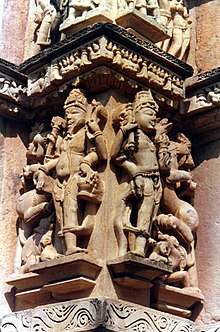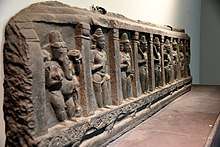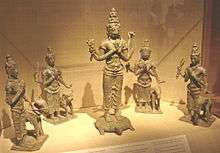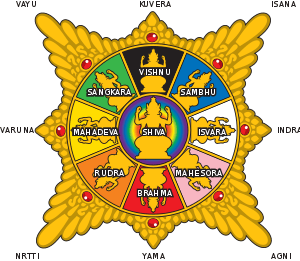Guardians of the directions
In Hinduism the Guardians of the Directions (Sanskrit: दिक्पाल, Dikpāla) are the deities who rule the specific directions of space according to Hinduism, Jainism and Vajrayāna Buddhism—especially Kālacakra. As a group of eight deities, they are called Aṣṭa-Dikpāla (अष्ट-दिक्पाल), literally meaning guardians of eight directions. They are often augmented with two extra deities for the ten directions (the two extra directions being zenith and nadir), when they are known as the Daśa-Dikpāla. In Hinduism it is traditional to represent their images on the walls and ceilings of Hindu temples. They are also often portrayed in Jain temples, with the exception that Nāga usually takes the place of Vishnu[1] in the nadir. Ancient Java and Bali Hinduism recognize Nava-Dikpāla, literally meaning guardians of nine directions, that consist of eight directions with one addition in the center. The nine guardian gods of directions is called Dewata Nawa Sanga (Nine guardian devata). The diagram of these guardian gods of directions is featured in Surya Majapahit, the emblem of Majapahit empire.



There are strong similarities between the concept of the guardians of the directions and the lore surrounding the Chinese four symbols, four ancestral spirits who are responsible for four of the cardinal directions (North, South, East, and West).
The names of the Dikpālas vary slightly, but generally include the following:
| Name | Direction | Mantra | Weapon | Consort | Graha (Planet) | Guardian |
|---|---|---|---|---|---|---|
| Kubera | North | Oṃ Śaṃ Kuberāya Namaḥ | Gada (mace) | Bhadra | Budha (Mercury) | Ila |
| Yama | South | Oṃ Maṃ Yamāya Namaḥ | Pasam (Ropes) | Yami | Maṅgala (Mars) | Mangalaa |
| Indra | East | Oṃ Laṃ Indrāya Namaḥ | Vajra (thunderbolt) | Śacī | Surya (Sun) | Suryaa |
| Varuṇa | West | Oṃ Vaṃ Varuṇāya Namaḥ | Pāśa (noose) | Varuni | Śani (Saturn) | Shanini |
| Ishana | Northeast | Oṃ Haṃ Īśānāya Namaḥ | Triśūla (trident) | Ishani(form of parvati) | Brahspati (Jupiter) | Taraka |
| Agni | Southeast | Om Aam Agniaaya Namah | Danda(Staff) | Svaha | Shukra(Venus) | Shukraa |
| Vāyu | Northwest | Oṃ Yaṃ Vāyave Namaḥ | Ankusha (goad) | Lehari | Chandra (Moon) | Chandrika |
| Nirrti (form of Parvati) | Southwest | Oṃ Kṣaṃ Rakṣasāya Namaḥ | Khaḍga (sword) | Shiva | Rahu | Shivani |
| Brahmā | Zenith | Oṃ Hriṃ Brahmaṇe Namaḥ | Padma (lotus) | Sarasvatī | Ketu | Brahmani |
| Viṣṇu | Nadir | Oṃ Kliṃ Viṣṇave Namaḥ | Chakra (discus) | Lakṣmī | Lagna | Vaishnavi |
Directions in Hindu tradition
Directions in Hindu tradition are called as Diśā, or Dik. There are four primary directions and a total of 10 directions.
| English | Sanskrit |
|---|---|
| North | Uttara, Udīcī |
| South | Dakṣīṇa, Avāchip |
| East | Pūrva, Prācī, Prāk, Aruna |
| West | Paścima, Pratīcī, Aparā |
| Northeast | Īśānya |
| Southeast | Āgneya |
| Northwest | Vāyavya |
| Southwest | Nairṛtya |
| Zenith | Ūrdhvā |
| Nadir | AdhaH |
Lokapālas

In Hinduism, the guardians of the cardinal directions are called the Lokapālas (लोकपाल), or Dikpalaka. Three main distinctions of Dikpalaka are recognized, being:
Aṣṭa-Dikpāla ("Guardians of Eight Directions")
Daśa-Dikpāla ("Guardians of Ten Directions")
Besides the eight guardians, the following are added:
Nava-Dikpāla ("Guardians of Nine Directions") — called Dewata Nawa Sanga in ancient Java and Bali Hinduism

See also
| Wikimedia Commons has media related to Guardians of the directions. |
References
- A Thousand Petalled Lotus: Jain Temples of Rajasthan : Architecture & Iconography, Issue 42 of Indira Gandhi National Centre for the Arts Series,, Sehdev Kumar, Abhinav Publications, 2001 p. 17
- Gopal, Madan (1990). K.S. Gautam (ed.). India through the ages. Publication Division, Ministry of Information and Broadcasting, Government of India. p. 71.
- Dictionary of Hindu Lore and Legend (ISBN 0-500-51088-1) by Anna D(allapiccola
- The Gods of the Directions in Ancient India. Origin and Early Development in Art and Literature (until c. 1000 A.D.), Berlin: Dietrich Reimer 2001 (ISBN 3-496-02713-4) by Corinna Wessels-Mevissen
